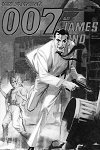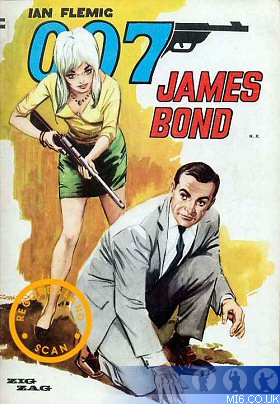|
| |
 |
| |
MI6 looks back at the history of the Zig Zag
"007" James Bond comic book series published in Chile,
Argentina, Peru and Paraguay in 1968...
| |
Zig Zag "007" James Bond Comic Books
13th May 2007
Six years after Sean Connery exploded
on to the world stage as James Bond in "Dr
No", the global phenomenon of 007 left fans in
South America hungry for more.
Chilean publisher Zig Zag
secured a licence to publish James Bond comic books in
Argentina, Chile, Paraguay and Peru in 1968.
Rather than a two man team, like that
which produced the British
newspaper strips, Zig Zag used artist and writer Germán
Gabler to produce some of the adventures. Gabler
was born in Santiago, Chile in 1942, and began drawing
in his early childhood.
He first worked as a professional
comics artist with the help of Jorge Carvallo, who introduced
him to the publishing house Zig Zag. He was initially
hired as a scriptwriter, and cooperated with his brother
Guillermo
on several stories.
Right: Cover art for an
issue of 007 from Zig Zag. James Bond (Sean Connery) would
often wear a white tuxedo. |
|
 |
Gabler had the advantage of
fluent English, and could use Ian
Fleming's source material years before they were translated
in to Castilian. Following the lead from the movies, Gabler's
adaptations
would often include a glossy and fast paced "pre-title sequence" with
the main story based on Fleming's work, but later diverged in
to his own original stories. Although licenced through Glidrose
(now Ian Fleming Publications), and tied to the literary 007,
the depiction of Bond in the comics is clearly based on Sean
Connery's movie persona.
 |
|
Fellow Chilean artist Abel Romero provided
many of the covers and some interior art, which he once
said he sketched in the theatre whilst watching Bond films.
Romero was one of Chile's most prolific comic artists,
who had worked in the field since the 1950s. He studied
at the School of Arts at the University of Chile between
1945 and 1947. Shortly afterwards, he went to work for
the Propagandas Cañas agency, where he did promotional
art for North American movie companies. He was head of
the comic strip department of the Editorial Quimantú (the
former Zig Zag) around 1970.
As well as Gabler and Romero, the team
also included artists Hernán Jirón, Lincoln
Fuentes and Luis Avila.
Despite the publication suffering poor
print quality and artwork far from the realms of John McLusky
or Yaroslav Horak, Zig Zag's 007 publication proved successful
in South America. But when the Marxist Salvador Allende
was elected President in 1970, the political climate drastically
shifted in Chile and James Bond went from celebrated hero
to a symbol of Western fascism, causing the publication
to fold instantly. |
When the military regime came in 1973,
Romero focused on his advertising assignments, and traveled
through Peru and Europe. He eventually settled in Sweden
in 1978, and stayed there until 1993. During his stay in
Sweden, he drew for Semic, although did not contribute
to their James Bond publications.
When Zig Zag changed
to Quimantú, Gábler left the firm to work
in the industrial field for a while. Around this time,
he also began illustrating comic adaptations of novels
for an Argentine publisher. During the mid 1970s, he came
up with two magazines of his own.
The first one was Killer,
which was in fact a continuation of 007, but this time
with the face of Charles Bronson.
Later, Gabler became
General Manager of SGM and began contributing stories
to the British publisher Fleetway. His Fleetway assignments
were the final comics works he did. In the 1980s, he
focused
on his work for television and radio.
|
|
 |
Over its short run, Zig Zag's "007" publication
produced 59 issues, ending in the ironically titled "The
Condemned". The issues are now much sought after collectors
items, and building a complete set is a challenge worthy of any
serious 007 fan.
Related Articles
 Newspaper Strips Index
Newspaper Strips Index
 Comics Coverage
Comics Coverage
 All Comics Articles
All Comics Articles
|
| |